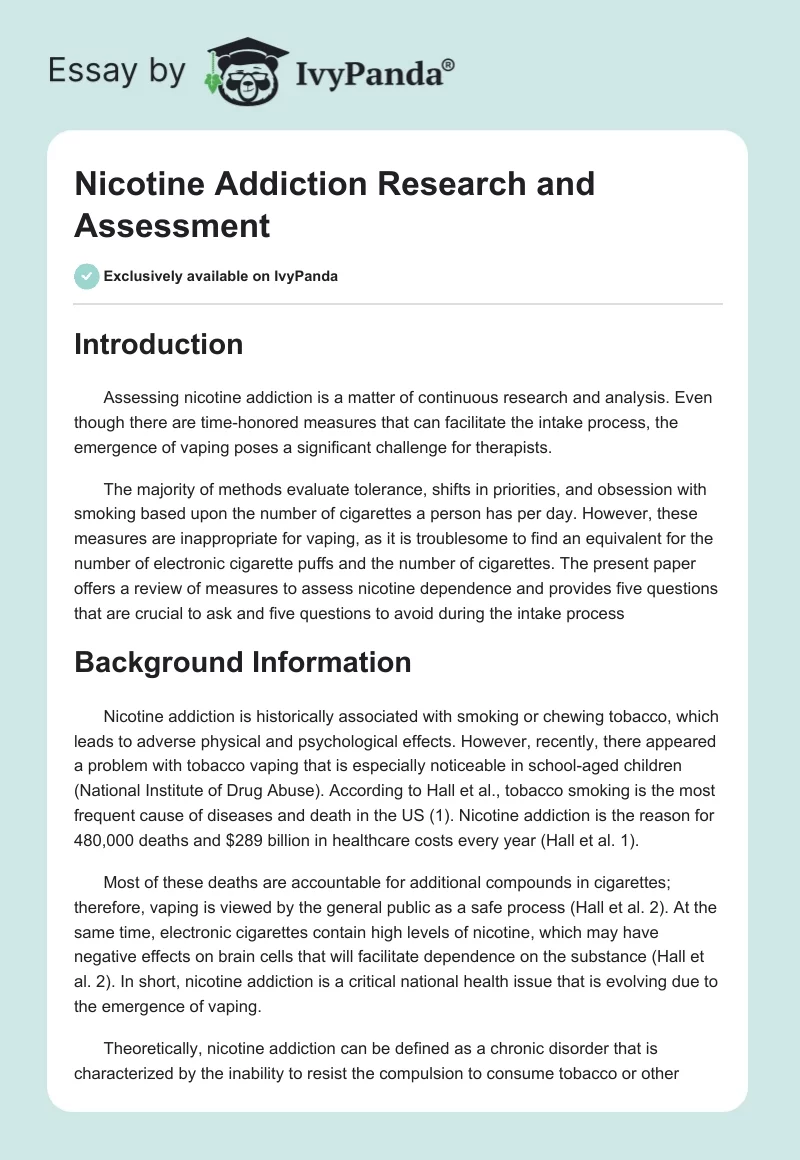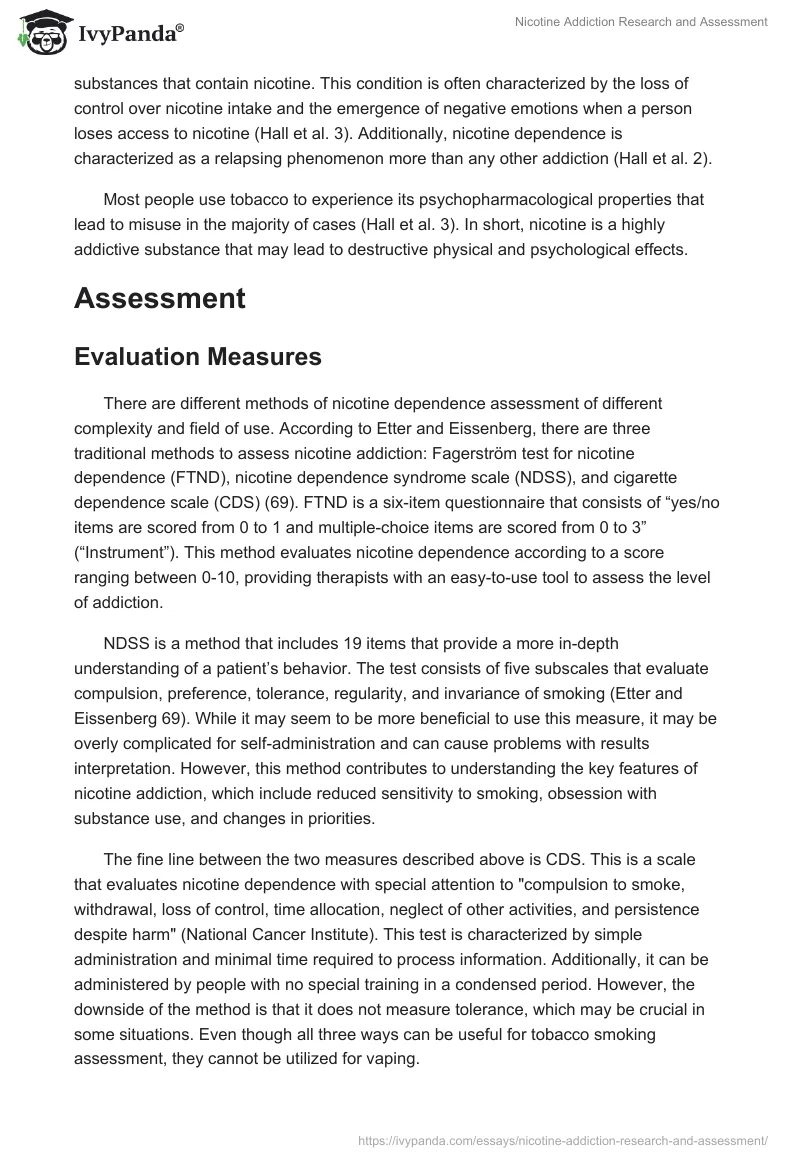Introduction
Assessing nicotine addiction is a matter of continuous research and analysis. Even though there are time-honored measures that can facilitate the intake process, the emergence of vaping poses a significant challenge for therapists.
The majority of methods evaluate tolerance, shifts in priorities, and obsession with smoking based upon the number of cigarettes a person has per day. However, these measures are inappropriate for vaping, as it is troublesome to find an equivalent for the number of electronic cigarette puffs and the number of cigarettes. The present paper offers a review of measures to assess nicotine dependence and provides five questions that are crucial to ask and five questions to avoid during the intake process
Background Information
Nicotine addiction is historically associated with smoking or chewing tobacco, which leads to adverse physical and psychological effects. However, recently, there appeared a problem with tobacco vaping that is especially noticeable in school-aged children (National Institute of Drug Abuse). According to Hall et al., tobacco smoking is the most frequent cause of diseases and death in the US (1). Nicotine addiction is the reason for 480,000 deaths and $289 billion in healthcare costs every year (Hall et al. 1).
Most of these deaths are accountable for additional compounds in cigarettes; therefore, vaping is viewed by the general public as a safe process (Hall et al. 2). At the same time, electronic cigarettes contain high levels of nicotine, which may have negative effects on brain cells that will facilitate dependence on the substance (Hall et al. 2). In short, nicotine addiction is a critical national health issue that is evolving due to the emergence of vaping.
Theoretically, nicotine addiction can be defined as a chronic disorder that is characterized by the inability to resist the compulsion to consume tobacco or other substances that contain nicotine. This condition is often characterized by the loss of control over nicotine intake and the emergence of negative emotions when a person loses access to nicotine (Hall et al. 3). Additionally, nicotine dependence is characterized as a relapsing phenomenon more than any other addiction (Hall et al. 2).
Most people use tobacco to experience its psychopharmacological properties that lead to misuse in the majority of cases (Hall et al. 3). In short, nicotine is a highly addictive substance that may lead to destructive physical and psychological effects.
Assessment
Evaluation Measures
There are different methods of nicotine dependence assessment of different complexity and field of use. According to Etter and Eissenberg, there are three traditional methods to assess nicotine addiction: Fagerström test for nicotine dependence (FTND), nicotine dependence syndrome scale (NDSS), and cigarette dependence scale (CDS) (69). FTND is a six-item questionnaire that consists of “yes/no items are scored from 0 to 1 and multiple-choice items are scored from 0 to 3” (“Instrument”). This method evaluates nicotine dependence according to a score ranging between 0-10, providing therapists with an easy-to-use tool to assess the level of addiction.
NDSS is a method that includes 19 items that provide a more in-depth understanding of a patient’s behavior. The test consists of five subscales that evaluate compulsion, preference, tolerance, regularity, and invariance of smoking (Etter and Eissenberg 69). While it may seem to be more beneficial to use this measure, it may be overly complicated for self-administration and can cause problems with results interpretation. However, this method contributes to understanding the key features of nicotine addiction, which include reduced sensitivity to smoking, obsession with substance use, and changes in priorities.
The fine line between the two measures described above is CDS. This is a scale that evaluates nicotine dependence with special attention to “compulsion to smoke, withdrawal, loss of control, time allocation, neglect of other activities, and persistence despite harm” (National Cancer Institute). This test is characterized by simple administration and minimal time required to process information. Additionally, it can be administered by people with no special training in a condensed period. However, the downside of the method is that it does not measure tolerance, which may be crucial in some situations. Even though all three ways can be useful for tobacco smoking assessment, they cannot be utilized for vaping.
Assessing electronic cigarette abuse may become a considerable problem for addiction specialists, as there are no unified methods for the matter. Etter and Eissenberg suggest that ten e-cigarette puffs are the equivalent of smoking one tobacco cigarette based on statistics (69). However, the intake process is prone to mistakes, as people take less consideration when vaping, making it difficult to count the number of puffs. Nonetheless, the method remains the most adequate due to a lack of research in the sphere. In summary, CDS and e-CDS (electronic cigarette dependence scale) seems to be the acceptable measures for assessing nicotine addiction.
Questions to Ask
The three measures discussed above can be summarized into five questions that would be sufficient to acquire an understanding of the level of a person’s dependency. The questions I would ask to elicit relevant information on an individual demonstrating signs of this addiction would be the following:
- How many cigarettes/e-cigarette puffs do you have per day?
- Usually, how soon after waking up do you smoke your first cigarette?
- Does the idea of having no cigarettes cause stress or discomfort?
- Do you find it difficult to avoid smoking in places where it is forbidden?
- When you are so ill that it causes you significant hardships to smoke, do you still find a way to have a cigarette?
I prefer the clients to answer the questions with as many details as possible and avoid yes/no answers. Even though such answers may appear challenging for processing, they provide valuable insights and help to establish interpersonal relationships with patients.
Questions to Avoid
There are five questions I would avoid during the interview process of potential nicotine addicts. First, I would not ask how many times he or she tried to quit smoking. It may lead to traumatic memories and interfere with the assessment. Second, I would avoid inquiring about the family history of addiction, which may appear inappropriate and does not have immediate relevance. Third, even though FTND includes a question of whether a person currently smokes/vapes, I consider it irrelevant, as such a person would not have consulted a therapist if they were not smoking/vaping. Fourth, I would not ask if a person uses other substances, and finally if he or she has any health conditions associated with nicotine abuse. Even though these five questions may seem valid, they may interfere with establishing a trusting environment between a therapist and a patient.
Conclusion
Addictions assessment is a sensitive process that must be carefully considered. Nicotine dependence is a frequent condition due to the emergence of vaping that is deemed to be harmless by the general population. This fact requires intake processes to be modified and refined to meet the requirements of quality care.
Works Cited
Etter, Jean-François, and Thomas Eissenberg. “Dependence Levels in Users of Electronic Cigarettes, Nicotine Gums, and Tobacco Cigarettes.” Drug and Alcohol Dependence, vol. 147, 2015, pp. 68-75. Web.
Hall, F. Scott, et al. Negative Affective States and Cognitive Impairments in Nicotine Dependence. Academic Press, 2017.
“Instrument: Fagerstrom Test for Nicotine Dependence (FTND).” Drugabuse. Web.
National Cancer Institute. “Cigarette Dependence Scale.” Cancercontrol. Web.
National Institute of Drug Abuse. “Monitoring the Future Survey: High School and Youth Trends.” Drugabuse, 2018. Web.


